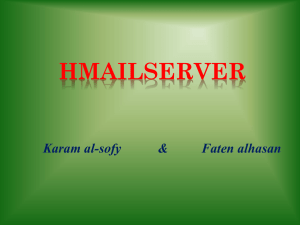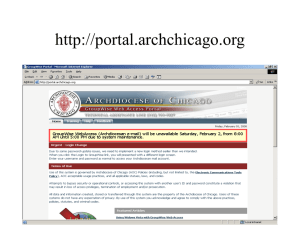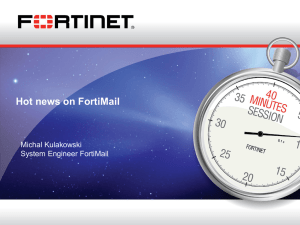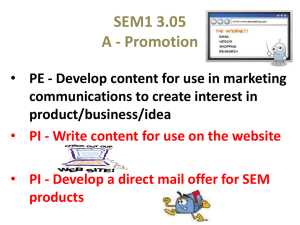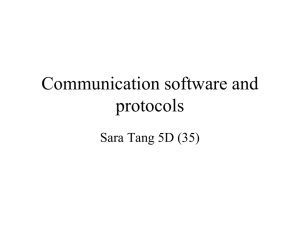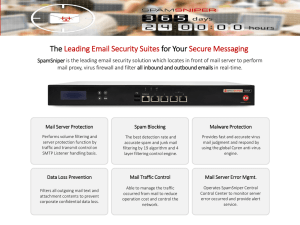Mastering the Internet, XHTML, and JavaScript
advertisement
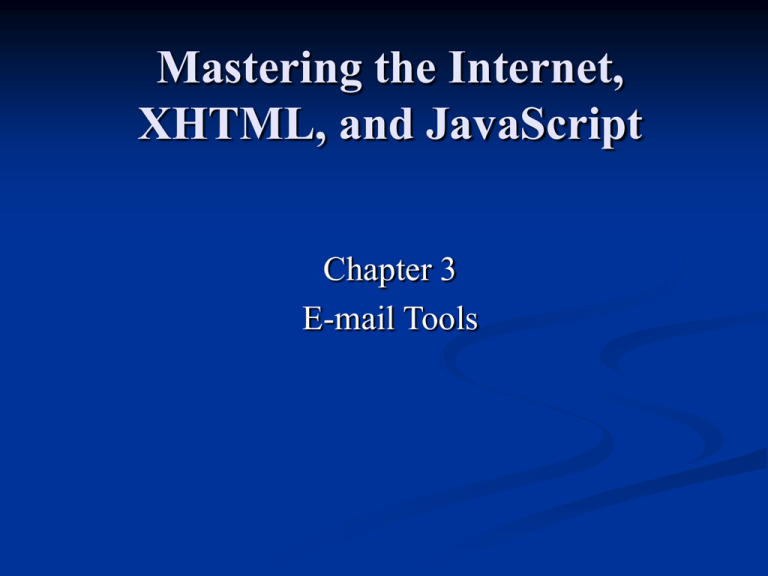
Mastering the Internet, XHTML, and JavaScript Chapter 3 E-mail Tools Outline Goals and Objectives Chapter Headlines Introduction Communication Protocols Content, Attachments, and Etiquette Acronyms and Emoticons E-mail clients and Web-based E-mail Eudora Outlook Express Netscape messenger and Mailer Opera M2 Hotmail Yahoo mail S-mail E-mail Activities Managing E-mail Wireless E-mail Summary Chapter 3 - E-mail Tools 2 Goals and Objectives Goals Understand and master the essentials of e-mail such as installation, configuration, types of e-mail programs, and the effective use of email clients and web-based e-mail Objectives Protocols : SMTP, POP3, IMAP, MIME Content, attachments, and etiquette Acronyms and emoticons E-mail clients versus web-based e-mail Software : Eudora, Outlook Express, Netscape, Opera, Hotmail, and Yahoo E-mail activities : receive, send, read, reply, forward, delete, organize Managing e-mails : signature files, vCards, stationary, address book, mailing lists, spam Wireless e-mail Chapter 3 - E-mail Tools 3 Chapter Headlines 3.1 Introduction E-mail is easy and intuitive to use 3.2 Communication The use of e-mail requires an e-mail account, ISP, and email program 3.3 Protocols SMTP, POP3, IMAP, MIME protocols are used 3.4 Content, Attachments, and Etiquette E-mail follows public and social etiquette and rules 3.5 Acronyms and Emoticons Acronyms save time, and emoticons express emotions and moods through facial expression symbols Chapter 3 - E-mail Tools 4 Chapter Headlines 3.6 E-mail Clients and Web-based E-mail There is a time and place to use either type of e-mail program 3.7 Eudora Eudora is a stand-alone client, and also available as web mail 3.8 Outlook Express Outlook Express comes built-in with Internet Explorer 3.9 Netscape messenger and mailer Netscape browsers have built-in e-mail clients 3.10 Opera M2 Opera Hotlist has all the user needs for e-mail Chapter 3 - E-mail Tools 5 Chapter Headlines 3.11 Hotmail Hotmail is free, easy to use, and popular 3.12 Yahoo mail Yahoo mail is web based, and is popular 3.13 S-mail Use s-mail for confidential, personal, or business communication 3.14 E-mail Activities All you need to know about using e-mails 3.15 Managing E-mail It is all about saving time, control, and fighting spam 3.16 Wireless E-mail Wireless E-mail and browsing have a lot in common Chapter 3 - E-mail Tools 6 Introduction E-mail is a method of communication over the internet that involves exchanging computer messages E-mail is the most widely used tool of internet Some advantages of e-mail are: Simple Intuitive Fast Like Internet, e-mail also uses a client/server model For using e-mail the user requires E-mail account on an e-mail server E-mail address E-mail software Internet connection Chapter 3 - E-mail Tools 7 Communication E-mail requires e-mail client and e-mail server E-mail servers communicate with internet and e-mail clients communicate with e-mail servers E-mail system usually has separate servers for sending and receiving Mail servers are managed and maintained by ISPs A client mail box typically has the following folders Inbox : to hold incoming mails Outbox : to hold copies of outgoing mails Draft : to hold to-send mails Trash : to hold to-delete mails Chapter 3 - E-mail Tools 8 Communication Chapter 3 - E-mail Tools 9 Protocols The communication is accomplished using 3 protocols: SMTP (simple mail transfer protocol) POP3 (post office protocol version 3) IMAP (internet message access protocol) SMTP is used for transferring e-mail over the internet POP3 and IMAP are used with SMTP to overcome its limited queuing ability Usually a user has SMTP outgoing mail server and SMTP and POP3 or SMTP and IMAP incoming mail server IMAP allows the user to access mail from any client computer connected to the internet, but with POP3, the user must download mails and then read them MIME protocol is related to e-mail content Chapter 3 - E-mail Tools 10 Protocols Chapter 3 - E-mail Tools 11 Contents, Attachments and Etiquette E-mail message has 4 parts: Header : includes From, To, Subject, and Date Body : includes the message body Signature : holds the senders information Attachments : allows the user to attach files to be sent E-mail messages can be sent to one or more persons E-mail message body can be plain text or XHTML E-mail message usually has an e-mail thread i.e. sequence of related e-mail messages generated from responses of the first new message E-mail attachments are handled by MIME protocol Chapter 3 - E-mail Tools 12 Contents, Attachments and Etiquette Chapter 3 - E-mail Tools 13 Contents, Attachments and Etiquette Email Etiquette Be concise and short Do not use too much punctuation Limit number of characters per line to 80 Avoid too much formatting Use salutations properly Use e-mail quote symbol, “>” Avoid flame Do not respond to flame Include all needed content in one message Chapter 3 - E-mail Tools 14 Acronyms and Emoticons An acronym is an abbreviation of a group of words An emoticon is a facial expression generated using keyboard characters Avoid over-use of acronyms and emoticons Examples of acronyms: 2L8 – too late ASAP – as soon as possible BRB – be right back FYI – for your information Examples of emoticons include: :-) – smiley ;-) – smiley with a wink ;-( – sad Chapter 3 - E-mail Tools 15 E-mail Clients and Web-based e-mail E-mail messages arrive at a server and then a client accesses them Client using POP3 protocol connects to internet, downloads the mails and then reads them later on. Client using the IMAP protocol connects to the internet and reads the messages while connected An e-mail client is a stand-alone program When the e-mail client is a web page it is web-based email User can configure an e-mail client to use POP3, or IMAP, or both Chapter 3 - E-mail Tools 16 E-mail Clients and Web-based e-mail POP3 is viewed as an e-mail forwarding protocol IMAP is viewed as on online e-mail reader POP3 is suitable for users who always use the same computer IMAP is useful for users who access e-mails using different computers Any type of e-mail client provides ways to read and manage e-mail activities E-mail clients also provide an address book to store email addresses of other people Chapter 3 - E-mail Tools 17 E-mail Clients and Web-based e-mail Chapter 3 - E-mail Tools 18 Eudora Eudora is a stand-alone email program It comes as and e-mail client or Web-based email Eudora can be downloaded from http://www.eudora.com It is intuitive to use One can customize Eudora by changing its settings and specifying incoming and outgoing mail servers Chapter 3 - E-mail Tools 19 Outlook Express Outlook Express is a stand-alone e-mail client provided by Microsoft It is bundled with Internet Explorer 6.0 It is suitable for individual user for personal use Users of Outlook Express should be aware of its viruses and security problems It can be downloaded from http://www.microsoft.com A user can customize Outlook Express to change its settings Chapter 3 - E-mail Tools 20 Netscape Messenger and Mailer Netscape browsers come with built-in stand-alone email clients The e-mail client allows the user to configure one POP3 server, but multiple IMAP servers They do not permit configuring mixed types of servers Chapter 3 - E-mail Tools 21 Opera M2 Opera browser comes with its built-in M2 e-mail client M2 has a built-in mail database and a search engine to search it Opera also provides web-based e-mail A user can sign up at http://www.operamail.com The use of Opera’s web-based e-mail is easy and intuitive Chapter 3 - E-mail Tools 22 Hotmail Hotmail is a popular web-based e-mail program A user can get his account at http://www.hotmail.com It is free and easy to use It has virus and security problems At peak times, it may be slow It has a limited disk space and sizes of mail attachments are restricted Chapter 3 - E-mail Tools 23 Yahoo Mail Yahoo mail is a popular web-based e-mail program A user can sign up for a free account at http://www.yahoomail.com It is easy to use and good at blocking unwanted mails It has disk space limitations Users can set up POP3 accounts for a fee Chapter 3 - E-mail Tools 24 S-mail S-mail means Secure Mail S-mail sends and receives mails over a secure connection Mails send using S-mail cannot be intercepted or altered The messages are encrypted and decrypted using public and private keys An e-mail client can be configured to provide S-mail Two available protocols are: S/MIME PGP/MIME Chapter 3 - E-mail Tools 25 E-mail Activities E-mail activities include: Configuring e-mail clients Creating e-mail accounts Reading e-mails Sending e-mails to single or multiple recipients Sending e-mails with attachments Forwarding e-mails Downloading attachments Printing e-mails Setting up auto-reply option Chapter 3 - E-mail Tools 26 Managing E-mail Managing e-mail means to deal with incoming and outgoing mails effectively It is important to manage e-mails to avoid mail box clutters Incoming e-mail management involves: Organizing Responding Deleting Archiving Filtering Spam, junk mail and bulk mail handling Chapter 3 - E-mail Tools 27 Managing E-mail Outgoing e-mail management involves: Electronic signatures vCards Stationeries Mailing lists Aliases Address books Chapter 3 - E-mail Tools 28 Wireless E-mail IMAP is the ideal protocol to use for Wireless E-mail There are three key concerns for wireless e-mail: 1. 2. 3. Security – Internet connection must be secure Single mail box integration – Syncing handheld device mail box with desktop mail box Push – e-mail is automatically delivered to the handheld device Chapter 3 - E-mail Tools 29 Summary • • • • • • • • E-mail is a widely used method of communication over the internet E-mail is based on a client/server model SMTP, POP3, IMAP, and MIME are important communication protocols for e-mail model A user must follow the e-mail etiquette guidelines and keep content relevant Acronyms and emoticons are useful but must be used wisely E-mails can be accessed by e-mail clients and web-based email Managing e-mails is important to avoid mail box cluttering Wireless e-mails have security and syncing issues Chapter 3 - E-mail Tools 30
